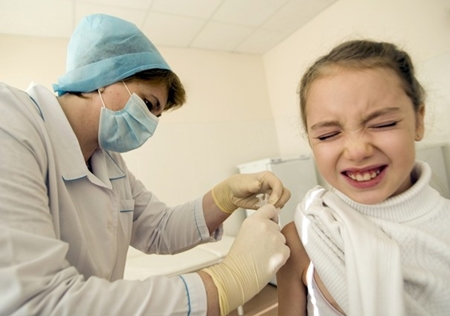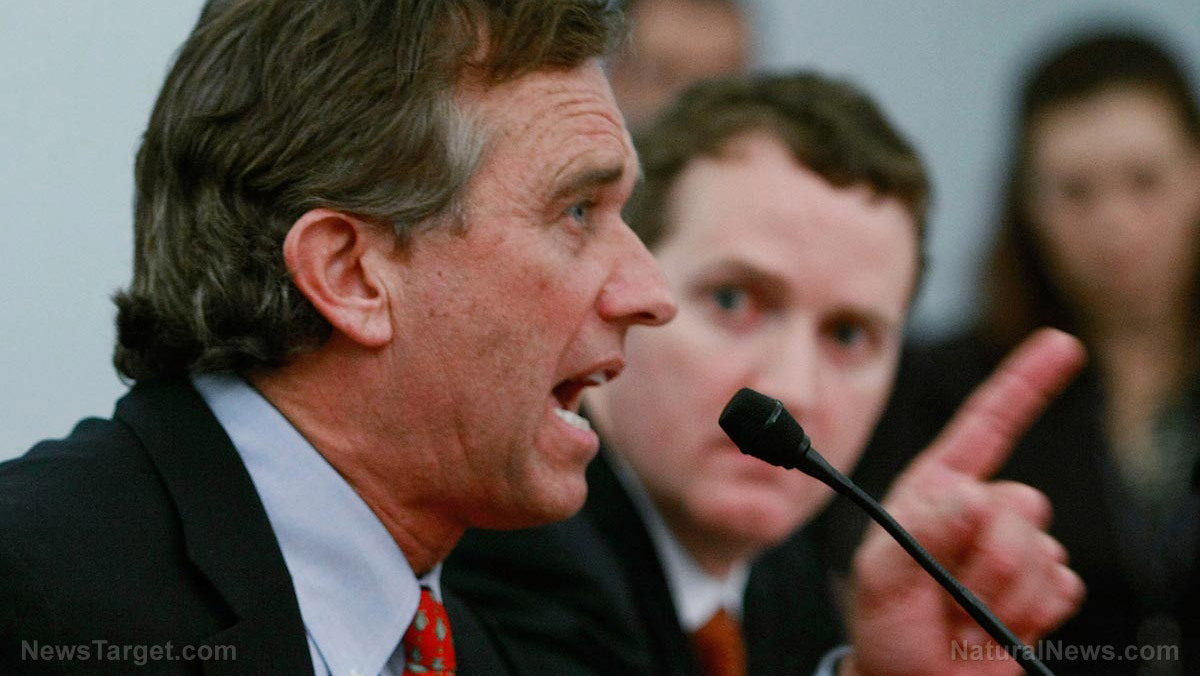Doctors continue to push untested “combination vaccines” even though they’re killing our children
03/24/2017 / By News Editors

It appears that the pharmaceutical industry is trying to cram as many vaccines as humanly possible into one syringe and advertise these combination vaccines as safe and effective. In reality, however, a growing number of medical professionals are concerned that administering too many vaccinations to an infant at one time increases their chance of suffering an adverse reaction.
(Article by Christina England from healthimpactnews.com )
This is especially the case for combination vaccinations, and it appears that the fears of medical professionals are justified, because, over the years, history has painted a very disturbing picture.
History Proves that Combination Vaccines are Unsafe
In October 2000, the 6-in-1 vaccination Hexavac was first licensed for use in Europe. The vaccine manufactured by Sanofi Pasteur was formulated as a combination vaccination that combined the diphtheria vaccine, tetanus vaccine, acellular pertussis vaccine, recombinant hepatitis B surface antigen vaccine, inactivated poliomyelitis vaccine and Haemophilus influenza vaccine in one syringe.
Just five years later, however, the vaccination was withdrawn from use by the European Medicines Agency for “commercial reasons.” However, Dr. Klaus Hartmann believes that the vaccine was withdrawn for very different reasons. In a 2015 documentary, titled We Don’t Vaccinate – Myth and Reality of the Vaccination Campaigns, he explained his reasons why.
To pay for a link to the full movie click here. Watch in HD/1080p.
Order DVD:
USA – GB – http://www.informedparent.co.uk/shop/we-dont-vaccinate-film-documentary
Dr. Hartmann worked for the licensing authority at the Paul-Ehrlich-Institute and was in charge of vaccine safety. He was not opposed to vaccination; however, he was concerned about the aluminum adjuvants contained in vaccines and was especially concerned about the 6-in-1 vaccination Hexavac because he had noticed a massive increase in the number of children suffering adverse reactions. He stated that:
Here we had another problem with Hexavac. A pathologist had autopsied a child who had died two days previously, after getting the Hexavac vaccine. He found that the child had a massively swollen brain, something that he had never come across before in his career as a pathologist. Several other cases were mentioned; it was not just this one child.
This observation had raised Dr. Hartmann’s concerns, because, at the time, the vaccine had been licensed as safe in Europe. He explained that experts had discussed the vaccine in depth during meetings and they had decided that it was not wise to connect the vaccine to the deaths of these babies because politically, it was not considered, “a smart thing to do, to damage the public’s trust in vaccinations.”
Consequently, Dr. Hartmann resigned from his post, and a year later, the Focus magazine stated that the mortality rate among the vaccinated babies in the first 48 hours after a vaccination with Hexavac was 2.5 times higher than the average mortality in this age group.
A year later, Hexavac was taken off the market and disappeared forever. Within a few months, a study titled the Token study was published, which, according to Austrian investigative journalist Bert Ehgartner, was a scandal and in a class all of its own. He explained that:
Naturally people became very disquieted simply because the probability of death following a vaccination had been shown to triple, so there they sat in conference rooms, asking themselves how they could handle the situation. Fortunately, they had good advisors because these idiots at the Robert Koch Institute had their study financed completely by the vaccine manufacturers, which is why when all this happened they had to immediately notify their sponsors industry, for the more they wanted to have experts available for dealing with the public relations aspect of the vaccinations, they of course are employed by the vaccine manufacturers themselves.
He continued:
The publication of the study results was delayed for two years, as the pharma industry had to hold numerous meetings and lectures to address the issue. Finally, they announced that everything was OK, that absolutely nothing unethical had happened, they simply reshuffled data and redefined parameters, they simply used statistics to make the link between the vaccinations and the casualties disappear.
Confirming the information that had been relayed by Dr. Hartmann, Rolf Kron, M.D., explained that the more comprehensive English version of the Token study mentioned that hundreds of deaths had occurred after the vaccination. He stated that:
When looking through the data bank of the Paul-Ehrlich-Institute, you will find very few deaths and suspected cases, listed. At the same time constant mention of the fact that it is still unclear whether these cases are really vaccine related.
If now for example, there is no increase in the number of deaths between the fourth and the seventh day after vaccination, then only this is mentioned in the medical papers. When however, we take a look at the days before and after this period to find out what the mortality rate is, we suddenly see an enormous increase.
In the shorter German version, it is only stated that the vaccines are safe and that multiple vaccines pose no significant risk of an increase in the infant mortality rate.
For more information on this vaccine, read: European Medicines Agency – Hexavac, and European Medicines Agency – Committee for Medicinal Products for Human Use European Public Assessment Report (EPAR)
Another Lethal 6-in-1 Vaccine is Unleashed
In 2011, news leaked about another dangerous 6-in-1 vaccination, which had also been licensed as safe and effective.
Reports revealed that a confidential GlaxoSmithKline document had been leaked to the press, which exposed the fact that within a two-year period, a total of 36 infants had died after they had received the 6-in-1 vaccination, Infanrix Hexa.
According to the Initiative Citoyenne website, a 1,271-page document had revealed that GlaxoSmithKline had received a total of 1,742 reports of adverse reactions between October 23, 2009, and October 22, 2011, including 503 serious adverse reactions and 36 deaths. Initiative Citoyenne stated:
It’s not that 14 deaths were recorded by GSK between October 2009 and end in October 2011 as we had originally calculated but 36 (14 from 2010 to 2011 and 22 from 2009 to 2010). In addition to these 36 deaths at least 37 other deaths (sudden death mainly), bringing the total to at least 73 deaths since the launch of the vaccine in 2000, and again, this concerns only the death by sudden death, no further recovery of under-reporting.
Using the figure of 36 deaths over a two-year period, the figures averaged 1.5 deaths per month, which I am sure most will agree is extremely high. It should also be noted that only 1 to 10% of adverse reactions to vaccines are actually reported. Therefore, in reality, the problem could potentially be far more serious and the actual number of fatalities could have been much higher.
The Deadly Chemical Cocktail
The charts revealed that many of the infants who had passed away had died within the first few days of receiving the vaccine. A total of three infants were reported to have died within hours of receiving the vaccine.
This was hardly surprising, given the vaccination’s ingredients, which were listed on the GSK Infanrix Hexa product information leaflet.
Sadly, it is not only the 6-in-1 vaccinations that are believed to be killing our children, because according to reports, multiple deaths are also occurring after the 5-in-1 vaccinations.
Reports from India
Towards the end of 2016, a flood of reports from India revealed that 237 children had died after being vaccinated with pentavalent (5-in-1) vaccinations.
In November 2016, the website SundayGuardianLive published an article titled 237 deaths by pentavalent vaccine and still counting. The author, pediatrician Jacob Puliyel, revealed that after submitting a Freedom of Information report, they were shocked to learn that:
Under Right to Information we know that up to August 2016 there have been 237 deaths reported to the government here within 72 hours of vaccination with pentavalent. We examined deaths in states which were giving DPT and pentavalent vaccine concurrently.
As expected, the true figures were never revealed to the public and any link to the vaccination went from being probable to “unlikely” extremely quickly. He wrote:
There were three deaths following the use of pentavalent vaccine in Sri Lanka. The Government of Sri Lanka suspended the use of the vaccine. WHO experts investigated the deaths. They found there was a clear temporal association of the deaths to the vaccine (WHO terminology, meaning the deaths followed soon after vaccination) and there was no alternate explanation for the deaths. According to the standard protocol in investigation of vaccine deaths these deaths would have to be declared as ‘probably’ caused by Pentavalent vaccine. The experts balked at the prospect of giving such a report. No country would use this vaccine after that. Instead they wrote in their report that they were deleting ‘probable’ and ‘possible’ from the standard classification. The report maintained that although it was probably related to the vaccine, they were reporting it as “unlikely” to be related to vaccination. The full report was not published online, only the conclusion was made public.
Read more at: healthimpactnews.com
RECENT NEWS & ARTICLES
COPYRIGHT © 2017 PENSIONS NEWS




















